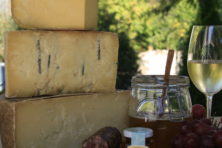The Cheese Insider
- Share
- Tweet
- Pin
- Share
Understanding the texture of cheese is an important way to recognize its flavor profile and taste qualities. The spectrum goes from fresh cheese with soft texture to hard cheese with more salt and often deep complex flavors.
Fresh or Soft Cheeses: These cheeses are unripened, meant to be eaten within a few days of production. They include: cottage cheese, chevre, feta, ricotta and mozzarella.
Semi-Soft Cheeses: This broad category includes high-moisture cheeses, usually not aged for a long period. They include: Colby, Monterey Jack, and Teleme.
Soft Ripened Cheeses: As these cheeses age, they ripen from the outside inward and become softer and creamier. The rind develops a white “bloomy” surface and, often, tangy flavors of milk, herbs, mushrooms, fruit, and salt. They include: Brie and Camembert. Les Frere and Petit Frere from Crave Brothers in Waterloo, WI, are other examples of this style of cheese.
Wash-Rind Cheeses: These cheeses are washed with a mixture of salt, Brevibacterium linens (commonly referred to as b-linens), and water, wine, cider or beer during the ripening stage. These cheeses also ripen from the outside in, but by a means of bacterial growth rather surface mold. In addition to the flavors from the milk, the bacterial activity adds a wide array of tastes and aromas. They include two of my favorite Wisconsin cheeses: aged brick from Widmer’s Cheese and St. Jeanne’s from Union Star Creamery.
Semi-Hard Cheeses: In contrast with semi-soft cheese, this category has less moisture – a result of how the cheese is made. The curds of these cheeses may be cooked, washed, cheddared, drained and then pressed – methods that remove more whey and result in a drier cheese. In addition, this style of cheese is aged longer which produces a harder consistency. They include a variety of cheddars: Widmer’s, Bandaged Cheddar from Blue Mont Dairy, and Kingsley from Roelli Cheese. This category also includes Pleasant Ridge Reserve, and the sheep milk cheeses from Hidden Springs Creamery.
Hard Cheeses: Going one step beyond the semi-hard, these cheeses have even less moisture and a very hard texture. A combination of heating the milk (which caramelizes its sugars), cutting the curds into very small pieces to expel more whey, and adding greater amounts of salt results in low-moisture, hard cheese. Much like wine, aging creates complexity and full, assertive flavors. Examples include: Holland’s Family Cheese extra-aged Gouda, Dante, a sheep milk cheese, and Sarvechivo Parmesan from Sartori.
Blue Cheeses: This is a broad category of cheeses, ranging from soft and creamy to hard and crumbly. The distinguishing feature is the presence of blue mold either in the veins throughout the cheese or on its surface. The mold strain used most often is Penicillium roqueforti which is added to the cheese during the early stages.
Wisconsin has always produced some of the finest blue cheese in America, including: Buttermilk Blue from Emmi Roth, Glacier Blue and Penta Blue from Sid Cook at Carr Valley, and the sheep milk Little Boy Blue from Hook’s Cheeses. This category also includes two of the most popular cheeses in our store: Dunbarton Blue, and Red Rock from Roelli Cheese, both cheddar cheeses with just a hint of blue.
We all have our favorite style of cheese, but I encourage you to try the great varieties you may not be as familiar with. The high quality of the cheese selection in Wisconsin makes that journey easy, and very tasty.



